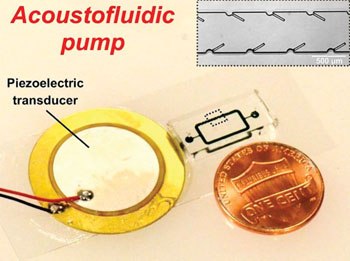Micropump Developed for Lab-On-A-Chip Disease Diagnosis
By LabMedica International staff writers
Posted on 18 Sep 2014
A reliable, inexpensive, programmable pump is a crucial feature for lab-on-a-chip devices that could make the diagnosis of many global life-threatening diseases easy and affordable.Posted on 18 Sep 2014
An acoustofluidic pump powered by a piezoelectric transducer has been developed that utilizes the acoustic streaming effects generated by the oscillation of tilted sharp-edge structures.

Image: An acoustically powered pumping device with 250 micron long oscillating structures driven by a piezoelectric transducer mounted on a glass slide shown next to US copper penny (Photo courtesy of Po-Hsun Huang and Tony Jun Huang).
Bioengineers and scientists at The Pennsylvania State University, (University Park, PA, USA) developed the pump which works by oscillating a series of thin sharp-edge structures hundreds of micrometers in length that have been constructed onto the sidewall of a microfluidic channel made of polydimethylsiloxane (PDMS), a widely used polymer. A miniaturized piezoelectric transducer, similar to the kind used in medical ultrasound, is the source of the oscillations.
The acoustofluidic pump was made by bonding a single-layer PDMS channel onto a single glass slide and attaching a piezoelectric transducer (Murata Electronics; Smyrna, GA, USA) adjacent to it using a thin layer of epoxy. To demonstrate the pumping behavior, the PDMS channel was designed to be a rectangular recirculating (in a counter-clockwise direction) channel composed of four portions: left channel, right channel, upper channel, and lower channel. The lower channel, referred to as the pumping region, was designed with 20 tilted sharp-edge structures on its sidewall, 10 on each side, while the other three channels were straight channels without any structures. The piezoelectric transducer, activated by amplified sine wave signals from a function generator (Tektronix; Beaverton, OR, USA) and an amplifier was used to acoustically oscillate the sharp-edge structures to generate acoustic streaming effects.
Tony Jun Huang, PhD, an engineering professor and senior author of the study, said, “Our pump is quite unique. It’s reliable and programmable, with a minimum of hardware, yet highly precise. The flow rates can be tuned across a wide range, from nanoliters per minute to microliters per minute. The permanent equipment for the total lab-on-a-chip system, including off-the-shelf electronics, could cost as little as about USD 25.00 to make, and the disposable chip could cost as little as USD 0.10. Although slightly more expensive than paper-based diagnostics, the system is far more versatile and precise, enabling quantitative analysis of, for example, human immunodeficiency virus (HIV), hepatitis, cancer, infectious diseases, cardiovascular diseases.” The study was published on September 4, 2014, in the journal Lab-on-a-chip.
Related Links:
The Pennsylvania State University
Murata Electronics
Tektronix




 assay.jpg)








